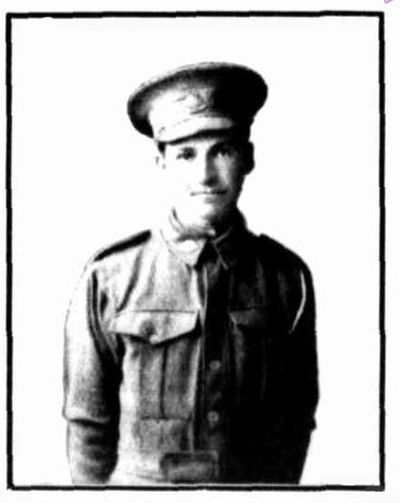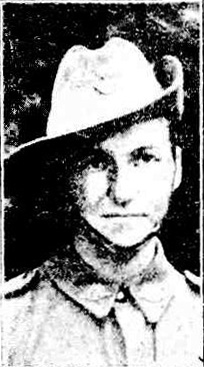Norman Sedrick Tonkin
From Our Contribution
 Sunday Times 29 Apr 1917, page 6S | |
 Western Mail 20 Apr 1917 page 23. | |
| Personal Information | |
|---|---|
| Date of Birth | 6 Apr 1897 |
| Place of Birth | Serpentine, Western Australia |
| Death | 8 Feb 1979 |
| Place of Death | East Victoria Park |
| Age at Enlistment | 18 years, 9 months |
| Description |
5"4½" (1.64m) tall ; 105 lbs 47.627 kg ; fair complexion ; brown eyes ; light hair |
| Occupation | Machinery assistant |
| Religion | Church of England |
| Address | NOK 223 Oxford street, Leederville, Western Australia |
| Next of Kin | Mother , Mrs Eliza Tonkin |
| Military Information | |
| Reg Number | 818 |
| Date of Enlistment | 26 Jan 1916 |
| Rank | Private |
| Unit/Formation | 44th Battalion, D Company / 11th Brigade, 3rd Division |
| Date of Embarkation | 6 Jun 1916 ‒ 21 Jul 1916 |
| Ship Embarked On | HMAT A29 Suevic |
| Date of Return | 21 Jun 1919 ‒ 3 Aug 1919 |
| Ship Returned On | SS Königin Luise |
| Fate |
Wounded in Action 24 Jan 1917 Wounded in Action 16 Oct 1917 (gassed) Wounded in Action 2 Jun 1918 (gassed) |
| Monument | Serpentine Roll of Honour |
| Medals |
British War Medal Victory Medal |
Pre War
War Service
On entering Blackboy Hill camp, Norman was allotted to the 44th Battalion and sent to the Claremont camp for training.
During the voyage to England they disembarked in Durban and undertook a 6 Mile (10Km) route march through the city. They were in Durban from 10 - 22 Jun 1916, so for longer than a normal coaling stop. They also stopped off in Cape Town from 24 - 27 June 1916, and St Vincent in the Cape Verde Islands overnight 11- 12 July 1916. Two men died during the voyage and were buried at sea. In Durban on 21 Jun 1916 Norman was charged with Breaking ship and being AWOL. His punishment was no further shore leave during the trip and fatigue duties until they disembarked in England. On 28 Jun 1916 Norman was again charged, this time for 'Coming on Parade - guard unshaven and untidy - a fine of 2/6d (25 cents)
On arrival in England they proceeded to Larkhill camp for their field training to prepare for trench warfare.
Proceeded overseas to France on 25 Nov 1916 and moved north into reserve at Steenwerck. On 24 Jan 1917 they were re-entering the line outside Armentiers when Norman was injured by enemy shelling. One other was killed and 5 men in addition to Norman were wounded. Norman's injuries were slight as he remained on duty. He was later detached to act as runner between the battalion and their Brigade's Headquarters.
Wounded again on 16 Oct 1917 when he was affected by mustard gas shells fired by the Germans when the battalion was in the front lines east of Ypres. The battalion's total casualties for that month were 15 Officers and 322 men.
Treated first by the 3rd Australian Field Ambulance before being passed back to the 10th Casualty Clearing Station, and then in turn to the 2nd Australian General Hospital annex at Wimereux, France on the 17th. On 20 Oct 1917 he was embarked on HMHS St Denis for England, where on 21 Oct 1917 he was admitted to the 1st Birmingham War Hospital. Norman was granted furlough from 7 Dec 1917 till 21 Dec 1917 before reporting to No 1 Command Depot at Sutton Veny. Still in Sutton Veny in March 1918, Norman was charged with being AWOL from 6.30pm on 5 Mar 1918 until 5.35am on 6 Mar 1918 for which he was admonished and lost a day's pay.
Transferred to the Overseas Training Brigade at Longbridge Deverill on 9 Apr 1918, Norm was sent overseas again on 8 May 1918 via Folkestone. Ten days later he rejoined the battalion at Pont Noyelles in the Somme valley where they were training and preparing to move to Villers-Bretonneux where they relieved the 16th Battalion in the front line.
On 2 Jun 1918 Norman was again affected by gas near Blangy-Tronville, and although the battalion war diary doesn't make mention of gas shells on the day, Neville Browning's book tells us"A Phosgene gas and high explosive bombardment of two hours duration descended onto the 44th Battalion's area during the early morning of June 2nd. The gas alarm was sounded immediately as the first shells exploded, with the result that only a few casualties were inflicted. They were Privates Cox, Dinning, Gay, Saunders and Tonkin"[1]Admitted to the 10th Australian Field Ambulance, before passing through the 55th Casualty Clearing Station, he was placed on an Ambulance Train on 9 Jun 1918 and transported to the 12th General Hospital at Rouen, before being evacuated to England aboard HMHS Essequibo on 12 Jun 1918.
Back in England he was admitted for a second time to the 1st Birmingham War Hospital, then transferring on 28 Jun 1918 to the 3rd Australian Auxiliary Hospital at Dartford, and on 5 Jul 1918 to No 3 Command Depot at Hurdcott. He also required further medical treatment from the Delhi Hospital between 18 and 29 Jul 1918.
Married on 10 Aug 1918 to Florence May Cole of King's Heath, on 11 Sep 1918 he was transferred back to Sutton Veny and then on 18 Sep 1918 to the Overseas Training Brigade at Longbridge Deverill. Newly married he was AWOL from 8:30am on 27 Sep 1918 until 10:00pm on 30 Sep 1918 for which he forfeited 8 days pay. He was again in need of hospital attention from 10 Oct 1918 until 24 Nov 1918. On 25 Nov 1918 he transferred to the No. 2 Command Depot at Weymouth and the next day he was again AWOL, this time from midnight 16 Dec 1918 until 2:00pm 22 Dec 1918 (loss of 12 day's pay) and from Midnight 18 Feb 1919 till 10:30 am 19 Feb 1919 (1 day's pay).
Discharged by the 5th Military District on 17 Sep 1919.
Post War
Electoral Roll entries - 1925 at 111 Dorothy street, Gosnells a ploughman; 1931 - 1972 a labourer.
During WW2 Norman served in the Army Citizen Military Forces from 26 Mar 1940 until 16 Dec 1946 as a Corporal. His final posting being the 11th Detention Barracks.
Florence May Tonkin died 15 May 1972 in Gosnells.
Notes
- ↑ 'The Westralian Battalion - The Unit History of the 44th Battalion A.I.F., Neville Browning, Advance Press, 2004, page 299